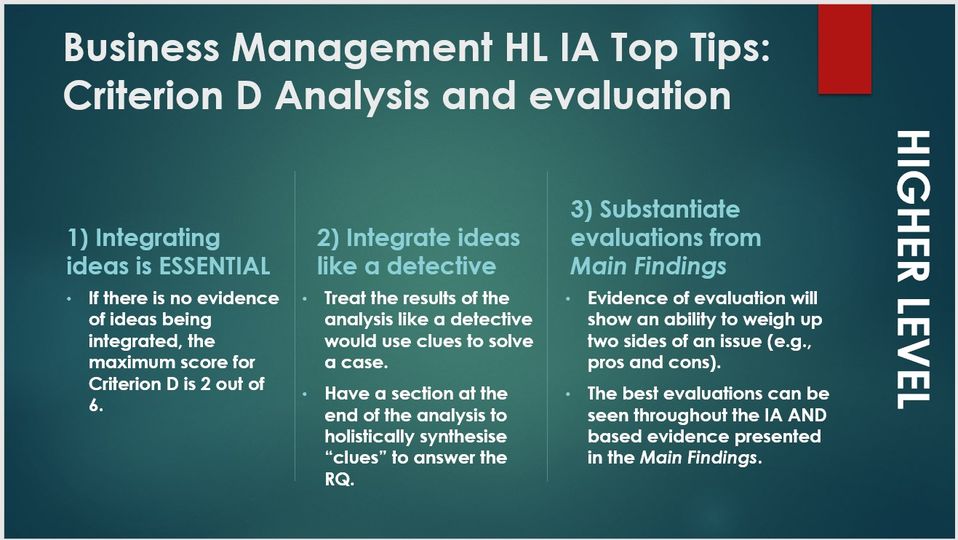Tuesday Top Tips - spotlight on Criterion D (HL & SL IA)
Tuesday 16 November 2021

HL IA Criterion D - Analysis and evaluation (written report) (Top mark band 6 marks)
This is the most challenging criterion for the HL IA. Even the highest achievers can struggle to reach a mark higher than 2 out of 6. However, if students submit a complete first draft of the IA, feedback based on the following tips can help them avoid stumbling on criterion D.
Integrating ideas is ESSENTIAL - If students treat each tool, technique, and theory (TTT) as discrete without synthesising their ideas, then the highest mark they will get awarded is 2 out of 3 as there is no evidence of integration of ideas.
Integrate ideas like a detective - Students need to think like a detective. Detectives do not rely on individual clues to solve a case. They need to gather as many clues as possible and piece them together into a logical narrative to solve the case. I recommend students have three to five sections in the Analysis and Discussion, one for each of the TTTs. At the end of each section, students should state a one sentence mini-conclusion to answer the research question on the basis of that particular TTT. Then at the end of the Analysis and Discussion, students should include evidence of holistic analysis. Here, they integrate the mini-conclusions together to form the basis of their overall conclusion. Each mini-conclusion from the TTTs acts as an individual clue. The “holistic analysis” pieces all the mini-conclusions together (i.e. piecing the clues together) in order to form the basis of the final conclusion (i.e. the logical narrative that leads to solving the case).
Substantiate your evaluation from the Main Findings - Students who remember to integrate their ideas and show evaluation of two sides of an issue (e.g. pros and cons or financial vs. non-financial factors etc.) can often fail to reach the highest markbands as they forget to incorporate evidence from their research. A well substantiated evaluation uses the evidence from their Main Findings to justify their points of view.

SL IA Criterion D - Conclusions (Top mark band 3 marks)
Adhere to the word limit - Examiners strictly abide by the word count limit. Any text beyond the 1,500th word in the written commentary will not be marked. Unfortunately for too many students, this often means their conclusion is not marked, causing the students to be awarded zero marks for Criterion D. Also, putting text or analysis in tables to circumvent the word count limit instead of the valid use tables will not be viewed upon kindly by examiners.
Write a sufficiently developed paragraph - One to two sentence conclusions will tend to be treated as superficial, thus preventing the student from getting anything higher than 1 out of 3 marks.
Answer the commentary question - Sometimes, students present an inconclusive answer to the commentary research question. An example of an inconclusive answer would be something like “In conclusion, Company XYZ should and should not pursue franchising as a growth strategy as there are many advantages and disadvantages to this strategy.” I tell students to pick a side and make a strong argument for that side so when they reach the conclusion, their definitive answer to their written commentary research question makes it clear and explicit for the examiner to apply the top markband.



